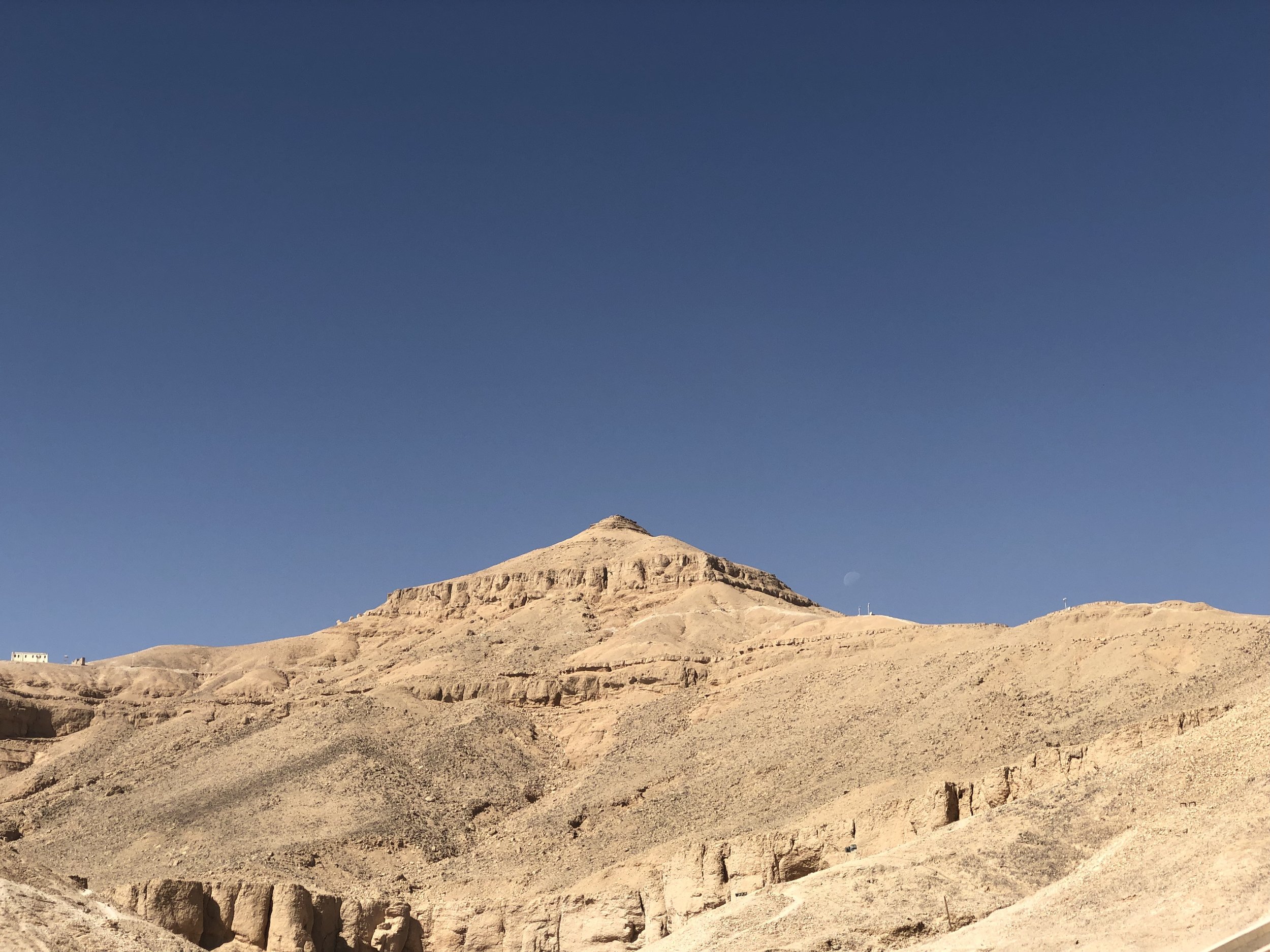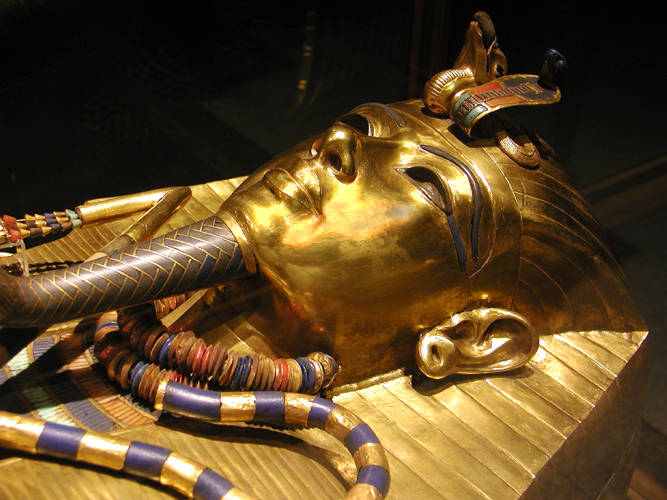Pharaohs were buried in elaborate underground tombs depicting their life and accomplishments and filled with everything their spirit would need for a comfortable afterlife.
When visiting Luxor, you must plan a morning excursion to the Valley of the Kings
Visiting the Valley of the Kings, the mortuary complex of Ancient Egyptian pharaohs has been a lifelong dream of mine. The massive royal necropolis is located in Upper Egypt on the West Bank of the Nile, opposite the ancient city of Thebes, now known as Luxor.
The ancient Egyptians believed that life was merely a brief passage of time followed by another where the deceased pharaoh would gain eternal access to move freely between the world of the living and the dead. The tomb provided a secure resting place and access to the supernatural realm, ruled over by the gods.
“The Ancient Egyptians believed that the soul split into two parts after death. The ka, or life force, was the individual’s double, which received the offerings it needed to survive. The second part was the ba, represented as a human-headed bird, which flew around during the day but returned to the tomb at night. ”
By the time Amenhotep I came to the throne, kings had learned from bitter experience that a monumental tomb, especially a pyramid, was more of a curse than a blessing. Advertising the location of the royal burial for all to see merely attracted the attention of tomb robbers and almost guaranteed that the deceased would not remain undisturbed for eternity. If the king were to enjoy a blessed afterlife, as intended, the nature of the royal tomb itself had to change.
As part of his wider program of religious remodeling, Amenhotep I implemented just such a radical redesign. From now on, the royal mortuary complex would be split into two distinct elements. A mortuary temple, sited prominently on a plain, would stand as the monarch’s permanent memorial and would act as a public focus for the royal cult. Quite separate, hidden away in the cliffs of western Thebes, a royal tomb cut deep into the rock would provide a secure resting place for eternity, without any outward sign to attract unwanted attention.
–Toby Wilkinson, The Rise and Fall of Ancient Egypt, 2010
Our guide Mamduh, from Egypt Sunset Tours, picked us up from our hotel at 8:30 a.m., and we set out on our West Bank excursion, which included the Valley of the Kings, the Mortuary Temple of Hatshepsut and the Colossi of Memnon. Because we’re ancient temple junkies, and we still had the better part of the afternoon, we also added the Tombs of the Nobles and Medinet Habu. Prices included a comfortable air-conditioned car, a driver, our English-speaking guide, Mamduh, and general entrance fees.
Wally and I arrived at the site around 9 a.m., avoiding the tourist rush and blistering heat of the late afternoon. It was already 87ºF and would climb over 100º.
The site was chosen in part because its tip, the peak of El Qurn, resembled a pyramid
Despite the name, the Valley of the Kings is comprised of two distinct valleys. The East Valley is where most of the royal tombs can be found. The site was chosen, in part as it was secluded, but also because it is dominated by the peak of El Qurn, a geological formation resembling a pyramid, sacred to the goddesses Hathor and Meretseger, both of whom were regarded as protectors of the dead. The West Valley contains the tombs of nobles and members of the royal family.
The official name for the rugged landscape in ancient times was Ta Sekhet Maat, or the Great Field, and beneath its barren surface lie more than 60 man-made subterranean tombs cut into the rock to commemorate the lives of New Kingdom pharaohs and wealthy nobles, which date from 1500 to 1070 BCE. The site’s most famous and intact tomb is that of the boy-king Tutankhamun, discovered by Howard Carter in 1922. Other famous pharaohs include Hatshepsut, the only female king, and a slew of Ramesside period monarchs.
Don’t you dare graffiti these tombs like those Coptic Christians!
To enter the World Heritage Site, Mamduh paid the entrance fee of 400 L.E., which included admission for only three tombs (you’re dependent upon which ones are open that day), a policy implemented to reduce crowds. We paid an additional 500 L.E. to see the tomb of Tutankhamun, and because we wanted to take pictures inside the tombs, we sprang for a 300 L.E. photography permit. (Note that you won’t be able to take photos inside King Tut’s tomb, even with a photography permit.) The tomb of Seti I, which also requires an additional fee, was closed at the time of our visit.
The bas-reliefs in the tombs are amazing, and many retain their original paint
Heads up: If you’re considering taking your chances and skipping the photo permit, don’t. We witnessed more than one tourist asked to show their permit, and when they didn’t have it, they were pulled aside and forced to delete their photos.
We took a yellow trolley up the paved road leading to the site entrance and disembarked at a secondary checkpoint, where you’ll be asked to show your tickets. All of the tombs are assigned a number, preceded by the acronym KV (Kings’ Valley), in the order of discovery, a system established by British Egyptologist John Gardner Wilkinson in 1827.
You can take one of these cute little yellow trams to get to the archeological site
Show your ticket at every entrance, and the guard will punch a hole in it to assure you only visit three.
You’ll be able to see three tombs per ticket at the Valley of the Kings
Tomb Raiders
Building a tomb was a massive undertaking and preparation for burial within the necropolis began the moment a pharaoh ascended the throne. The Ancient Egyptians believed that the soul had dual counterparts and split into two parts after death. The ka, or life force, was the individual’s double (represented symbolically with what I like to refer to as “goalpost hands” atop its head). The ka entered the tomb through a false door, usually above the sarcophagus, to receive the offerings it needed to survive. The second part was the ba, the mobile part of the soul, represented as a human-headed bird. The ba was thought to fly about during the day among the land of the living, but needed to return to the body at night.
The human-headed birds at the bottom are the ba, the part of the soul that can fly around and protect family members after death
A traditional tomb plan consisted of a long corridor, descending through one or more halls, reflecting the nightly descent of the sun-god Amun to the underworld. Most royal tombs had multiple rooms, with the last serving as the burial chamber. Egyptians believed that when a pharaoh died, he (or she) became Osiris, the god of the dead and ruler of the underworld.
Royal tombs have a long, slow descent to the burial chamber
Another feature common to most tombs is the well shaft, which may have originated as an actual barrier intended to stop seasonal floodwaters from entering the lower parts of the tombs but also served to provide water to the ka.
Although tombs were originally sealed after construction and the burial was completed, many were robbed by the workers of Deir el-Medina, the nearby village which was home to the artisans employed to build and decorate them.
This diorama shows the tombs they’ve discovered — which may be just a fraction of what’s buried in the valley
Our visit to the Valley of the Kings was a truly memorable experience, and because you’re limited to only three, be sure to take your time and don’t rush through them. –Duke







































